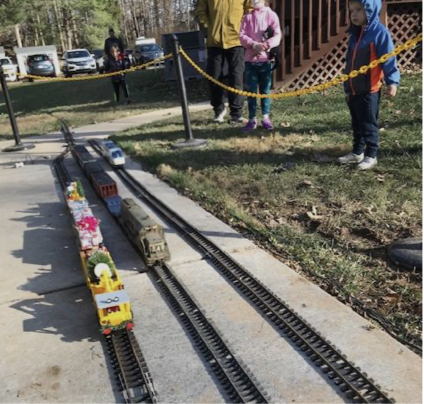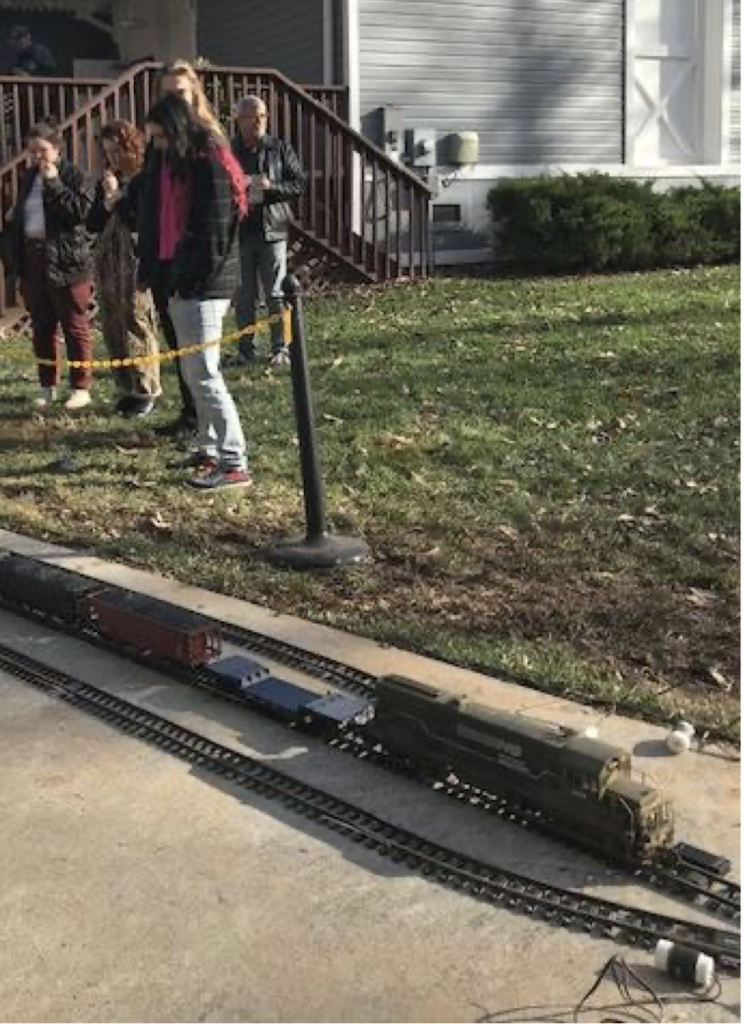WE’RE BACK!
After a two year Covid hiatus our club once again provided its fund raiser support to The Friends of Fairfax Station Museum. As always in years past, the main reason we do this civic layout is to assist with their annual December fund raiser.
This layout, and all others I’ve been involved with to date, when asked by friends “what do you do” I would describe it as “It’s nothing more than a bare bones, on the ground, track only layout.” Definitely it’s a far cry from our beautiful holiday layout display at the Brookside Botanic Gardens.
For Friday’s set up I had a sizable volunteer crew to lay out and assemble track. After several hours assembling track that included a little social time with a tasty pizza lunch, assembly completion followed then the all important test run. Test runs find trouble spots needing correction before we can say we’re finished ready for the next days operations. That was completed by early afternoon and we were ready to go. Setup started with everyone getting underway not long after the 9AM start although not everyone had arrived by then. As they arrived they too joined in as the others already had knowing what we do from having done it many times before. It’s always been the same configuration. As a result little guidance was necessary.

All the track used is stored under the station just for this layout. Over the years all the track used for this has been donated to the club at various times from members who were either moving away or no longer wanting their layouts. Because of these donations there was no need any longer to share our club track with personal member track brought just for this layout.
We did, as we always do, set up an extensive one-track loop completely around the perimeter of the station. And yes it’s always directly laid out on the ground stabilized by lots of Caesar shakes used for leveling. At opposite areas of the loop are two long, siding passing tracks. One is positioned at the far side of the station for when multiple trains are out sharing the main line. These sidings are necessary for allowing slower trains to give way to faster so the latter can pass by on the mainline without colliding. Near our power on a concrete pad (pictured) is the other passing siding set to one side of the mainline, and a lengthy section of open ended siding for the staging trains.
Specifically for the kids, a section of track is diverted off the big mainline loop that “tunnels” under a deck ramp walkway then rejoins the mainline. Kids love this tunnel. Kids quickly run to lay, yes lay, belly down on the ground, some coatless regardless the ground condition. “Here comes the train! It’s coming out of the tunnel”. Remember I indicated the ground everywhere was at least wet causing soggy conditions? This is a outside layout we do in December, and it’s winter!. It doesn’t seem to matter to them. No matter ground conditions (twice in the past there’s been snow) they just have to see trains coming at them while laying on the ground. What mud!
Public participation was light but steady for both days of operations. The Station’s post-COVID restart may have had something to do with the lighter attendance after two years dark. It’s difficult to know for sure. Trains did run as well as could be expected considering how much rain kicked off our morning for the Station’s Saturday reopening.

Fortunately, our G-scale trains are less than bothered by rain. The grounds, however, that’s a different story, didn’t fare as well from the overnight into morning rain. All the trackage fared well passing through pooling water and wet, soggy ground here and there. A light rain continued most of the morning up until 10 turning areas of the layout in back of the station became a sloppy mess. Still kids, not bothered in any way, ran through the wet, the mud, and the water running just to stay with our trains. Our Fairfax Station layout is the only layout we do where we allow kids to run beside our trains.
What we don’t allow, kids try anyway occasionally being kids. They straddle the track to make “leg” tunnels for the train to pass under them. For obvious reasons, foot hits cause derailed cars sometimes damaging them. They still try!
By mid-afternoon Saturday the predicted clearing gave us a much appreciated warmer, sunny afternoon, definitely a much more enjoyable day for running trains for the folks who did come. Sunday, the shorter 4-hour day skies remained clear only to turn cooler by the 4PM teardown.
The grounds around the station had not improved the slightest over the night before. Sloppy conditions prevailed. It did not deter us, nor those who came to see trains. And definitely not for the kids there to run with the trains. And they did!
The shorter day Sunday we were up and running early before the event’s opening at noon. The day, unlike the rainy morning of the previous day, was bright, temperatures moderate, more the perfect type day to be outside operating trains for the public than like the afternoon finally became the day before. Yet even with the soggy ground conditions, the areas of mud and water around and under track, nothing deterred kids from laying on the wet ground at the deck ramp tunnel waiting for the train to come through.
My operations crew for the two days were on the lighter side, thin in fact, just three, but it worked. Our volunteer layout pool seems to be dwindling. Set up on Friday and teardown Sunday produced reasonable crews. I would have loved to have had a few of them to assist with the two days of operations. It was not to be, but all was manageable.
All in all another successful kick-off layout after the 2-year COVID hiatus.
My crew for the three days: Joel Magram, Paul Staller, Grant Berry, Steve Shaner, Bill Krayer, Jeff Mitulla, Jim O’Connell, and Tom Reohl. My greatest appreciation and sincerest thank you to all of you for pulling together to promote another successful club sponsored event.
Story and photos by John Waters-Heflin


